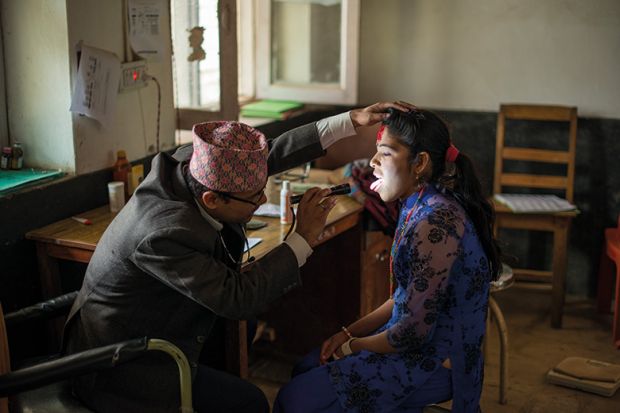Publications matter. And not just journal papers. For research aimed at improving people’s health by changing how international health services are delivered, other publications such as operational guidelines for managers, practice guides for doctors, and materials for the public that explain diseases, treatments or lifestyle changes in simple language, are just as important.
These are the publications that show that your research is really doing its job. Too often health service researchers pay lip service to collaboration while in reality their research is done “on”, rather than “with”, health professionals and policymakers in another country, with academic outputs the real target rather than tangible improvements in patient care.
While the UK government’s £1.5 billion Global Challenges Research Fund provides a welcome and long overdue focus on international development research, it does risk accentuating this problem. With more money available, more researchers may be tempted to try their hand at health service research without a full understanding of how to ensure that positive results can be scaled up and fully implemented in that country, and even beyond.
Implementation can’t be an afterthought: once your research is complete, it’s too late to interest the powers that be in your results. Rather than “consulting” with local decision-makers, going away and conducting research then trying to sell that tested intervention, the research needs to be “embedded” in national governmental health programmes from the start.
“Embedded” means that the research questions are developed from the perspective of the users and ministry of health decision-makers, based on the outcomes that they need. A technical working group involving decision-makers, local non-governmental organisations and researchers can then design the interventions and care packages to be delivered through the local health service, ensuring that they are tested in real-world conditions.
For example, we designed a recent intervention to reduce cardiovascular disease in China with the Zhejiang Center for Disease Control and Prevention, a government agency, and China Global Health Research and Development, a NGO that could support implementation and evaluation.
Research that is embedded in this way can be more easily scaled up from a small pilot to a randomised controlled trial involving multiple centres, before the fully tested intervention is rolled out across a country or region. The Chinese intervention, which is designed within existing policy and includes training doctors to give preventive treatment with anti-hypertension drugs, statins and aspirin and to encourage lifestyle changes such as reduced salt intake, was piloted in one hospital in the Zhejiang region before a randomised controlled trial got under way across 67 hospitals involving about 30,000 patients.
If the long-term outcome is – as we hope – a reduction in cardiovascular disease, the Zhejiang Center has the authority to roll out the programme regionally. It can also be easily taken up by their counterparts in other regions because it is designed to work in Chinese healthcare structures.
Trialling the intervention or care package in the local healthcare system also means that implementation costs are covered by that system, so the research grant can go further. But the real benefit is ensuring that the intervention is tested in real-world conditions. In the Chinese trial, we’ve seen that although doctors involved in the intervention are prescribing more statins, the take-up has been lower than expected, probably because only 30 per cent of the costs are covered by Chinese health insurance.
If a trial provides free drugs, any outcomes disappear once such a system is implemented in a healthcare system where drugs are charged for. In this way, embedded research helps highlight issues that policymakers can then choose, if they so wish, to address. Meanwhile, we are conducting similar intervention piloting and trials, but adapted to very different contexts, in Pakistan and Swaziland.
Of course, following all these steps takes time, but the result is a change in people’s health outcomes that can be sustained. One of our most successful projects began in 2008, working with the national tuberculosis programmes in Pakistan who were struggling to implement World Health Organisation guidelines stipulating that TB patients must attend a health centre daily for the first two months of their treatment.
Many patients were not following their treatment through as the visits caused excessive disruption to their daily lives, resulting in loss of work, schooling, etc. Working with TB programme managers and local NGOs, we designed and tested an alternative system that drew on family members or community health workers to support regular treatment. It worked, and this has now been scaled up throughout Pakistan and rolled out to Nepal, improving how 300,000 people with TB are cared for and protecting nearly 200 million people from the disease.
It’s time that this approach became the norm, not the exception. With increasing public scrutiny of where our aid budgets go – and rightly so – we need to ensure that health service research becomes the shining example of money well spent, with clear impact and outcomes. However well intentioned, research that never makes it beyond an academic journal – however prestigious – to become an operational handbook is an opportunity lost.
John Walley, professor of international public health, University of Leeds, and co-research director of the Communicable Diseases Health Service Delivery research programme
POSTSCRIPT:
Print headline: Taking your research to the real world
Register to continue
Why register?
- Registration is free and only takes a moment
- Once registered, you can read 3 articles a month
- Sign up for our newsletter
Subscribe
Or subscribe for unlimited access to:
- Unlimited access to news, views, insights & reviews
- Digital editions
- Digital access to THE’s university and college rankings analysis
Already registered or a current subscriber?






